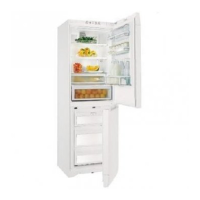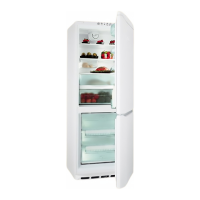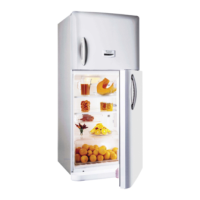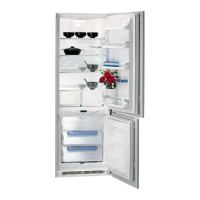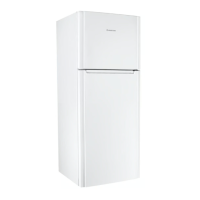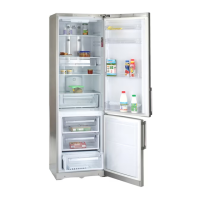Tips on Saving Energy
Keeping Your Appliance in Shape
GB
7
- Install it well
This means that the appliance should be installed
away from heat sources or direct sunlight in a well-
ventilated room.
- Correct temperature settings
Set the refrigerator or freezer temperature knob to one
of the medium settings. Very low temperatures will not
only consume a great deal of energy but will neither
improve or lengthen the storage life of the food. Ex-
cessively low temperature may in fact spoil vegeta-
bles, cold meats and cheese.
- Do not overfill
Remember that proper storage of food requires good
air circulation. Overfilling your appliance will prevent
this circulation and overwork the compressor.
- Shut the doors
Open your appliance only when strictly necessary;
remember that every time you open the door most of the
cold air will be lost. The motor will have to run, and consume
energy, to restore the correct temperature.
- Check the door gaskets
Keep the gaskets clean and soft so that they fit closely
against the door to ensure that no cold air is lost.
- Never store hot foods
A container of hot food in th e re frigerator will incre ase the
temperature significantly; allow food to cool to room tem-
perature before storing.
Defrosting
WARNING: do not d amag e the refrigeration circuit.
Do not use mechanical devices or other tools to speed
up the defrosting process, unless they have been rec-
ommended by the manufacturer.
How to Defrost the Refrigerator
This appliance defrosts automatically and the water is
drained to the back towards the drain pipe installed for this
purpose (fig. 1). Here, the heat produced by the compres-
sor will make it evaporate. The only thing you must do is to
periodically check and clean the hole of the drain, which
is located behind the vegetable crispers, so that the water
drains properly.
Fig. 1
How to Defrost the Freezer Compartment
- Every so often, remove the frost with the scraper provided
with the appliance (do not use knives or metal objects).
- If the frost is more than 5 mm thick, the freezer must be
defrosted.
Proceed as follows: turn the thermostat knob
(
B) to the ·
setting . Then wrap all the frozen and fast-frozen food in
newspaper, placing it either in the refrigerator or in a cool
place. Leave the freezer door open so that the frost thaws
completely(fig. 2). You can speed this process by placing
containers of warm water in the compartment.
Fig. 2
Cleaning and maintenance
Always unplug the appliance from the mains before
cleaning.
- Your appliance is manufactured with hygienic odourless
materials. To preserve these characteristics, always use
sealed containers for strong smelling foods to avoid the
formation of odours that are difficult to remove.
- Use only a water and bicarbonate solution: Clean the in-
ternal and exterior of your appliance with a sponge
soaked with a warm water and sodium bicarbonate solu-
tion, which is also a good disinfectant. If you do not have
any sodium bicarbonate at home, use neutral detergent.
- What not to use: Do not use abrasive detergents, bleach
or detergents containing ammonia. Never use solvent-
based products.
- Dishwashable: All the removable parts can be cleaned
by soaking in hot soapy water or detergent. If you own a
dishwasher, you may wash these parts in the dishwasher.
Remember to dry thoroughly before replacing them.
- What about the back panel? Dust may deposit on the
back panel and affect the proper running of the appli-
ance. To remove dust, vacuum away the dust very care-
fully using the appropriate vacuum cleaner accessory.
- Discontinued use of the appliance: If the appliance is not
in use for any length of time, remember to clean the inte -
rior and dry thoroughly, leaving the doors open to prevent
the formation of bad odours and mould.
- Interior refrigerator walls are covered with special anti-
bacterial layer, containing silver. This antibacterial layer
maintains hygienic environment and prevents from un-
pleasant odor. Antibacterial effect remains after repeated
cleaning with warm water.

